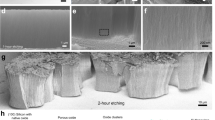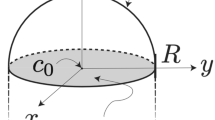Abstract
Nanowire growth by the vapour–liquid–solid (VLS) process enables a high level of control over nanowire composition, diameter, growth direction, branching and kinking, periodic twinning, and crystal structure. The tremendous impact of VLS-grown nanowires is due to this structural versatility, generating applications ranging from solid-state lighting and single-photon sources to thermoelectric devices. Here, we show that the morphology of these nanostructures can be further tailored by using the liquid droplets that catalyse nanowire growth as a ‘mixing bowl’, in which growth materials are sequentially supplied to nucleate new phases. Growing within the liquid, these phases adopt the shape of faceted nanocrystals that are then incorporated into the nanowires by further growth. We demonstrate this concept by epitaxially incorporating metal-silicide nanocrystals into Si nanowires with defect-free interfaces, and discuss how this process can be generalized to create complex nanowire-based heterostructures.
This is a preview of subscription content, access via your institution
Access options
Subscribe to this journal
Receive 12 print issues and online access
$259.00 per year
only $21.58 per issue
Buy this article
- Purchase on Springer Link
- Instant access to full article PDF
Prices may be subject to local taxes which are calculated during checkout




Similar content being viewed by others
References
Wagner, R. S. & Ellis, W. C. Vapor–liquid–solid mechanism of single crystal growth. Appl. Phys. Lett. 4, 89–91 (1964).
Hiruma, K. et al. Growth and optical properties of nanometer-scale GaAs and InAs whiskers. J. Appl. Phys. 77, 447–462 (1995).
Lauhon, L. J., Gudiksen, M. S., Wang, D. & Lieber, C. M. Epitaxial core–shell and core–multishell nanowire heterostructures. Nature 420, 57–61 (2002).
Samuelson, L. Self-forming nanoscale devices. Mater. Today 6, 22–31 (October, 2003).
Law, M., Goldberger, J. & Yang, P. Semiconductor nanowires and nanotubes. Annu. Rev. Mater. Sci. 34, 83–122 (2004).
Schwalbach, E. J. & Voorhees, P. W. Phase equilibrium and nucleation in VLS-grown nanowires. Nano Lett. 8, 3739–3745 (2008).
Tian, B., Xie, P., Kempa, T. J., Bell, D. C. & Lieber, C. M. Single-crystalline kinked semiconductor nanowire superstructures. Nature Nanotech. 4, 824–829 (2009).
Adhikari, H., Marshall, A. F., Chidsey, C. E. D. & McIntyre, P. C. Germanium nanowire epitaxy: Shape and orientation control. Nano Lett. 6, 319–323 (2006).
Dick, K. A. et al. Synthesis of branched ‘nanotrees’ by controlled seeding of multiple branching events. Nature Mater. 3, 380–384 (2004).
Burgess, T. et al. Twinning superlattice formation in GaAs nanowires. ACS Nano 7, 8105–8114 (2013).
Wen, C.-Y. et al. Formation of compositionally abrupt axial heterojunctions in silicon–germanium nanowires. Science 326, 1247–1250 (2009).
Lehmann, S., Jacobsson, D., Deppert, K. & Dick, K. A. High crystal quality wurtzite-zinc blende heterostructures in metal–organic vapor phase epitaxy-grown GaAs nanowires. Nano Res. 5, 470–476 (2012).
Caroff, P. et al. Controlled polytypic and twin-plane superlattices in III–V nanowires. Nature Nanotech. 4, 50–55 (2009).
Algra, R. E. Twinning superlattices in indium phosphide nanowires. Nature 456, 369–372 (2008).
Joyce, H. J., Wong-Leung, J., Gao, Q., Tan, H. H. & Jagadish, C. Phase perfection in zinc blende and wurtzite III–V nanowires using basic growth parameters. Nano Lett. 10, 908–915 (2010).
Huang, M. H. et al. Room-temperature ultraviolet nanowire nanolasers. Science 292, 1897–1899 (2001).
Duan, X., Huang, Y., Cui, Y., Wang, J. & Lieber, C. M. Indium phosphide nanowires as building blocks for nanoscale electronic and optoelectronic devices. Nature 409, 66–69 (2001).
Akopian, N., Patriarche, G., Liu, L., Harmand, J.-C. & Zwiller, V. Crystal phase quantum dots. Nano Lett. 10, 1198–1201 (2010).
Hochbaum, A. I. et al. Enhanced thermoelectric performance of rough silicon nanowires. Nature 451, 163–166 (2008).
Ross, F. M. Controlling nanowire structures through real time growth studies. Rep. Prog. Phys. 73, 114501 (2010).
Bartur, M. & Nicolet, M. A. Thermal oxidation of nickel disilicide. Appl. Phys. Lett. 40, 175–177 (1982).
Kallesøe, C., Wen, C.-Y., Mølhave, K., Bøggild, P. & Ross, F. M. Measurement of local Si-nanowire growth kinetics using in situ transmission electron microscopy of heated cantilevers. Small 6, 2058–2064 (2010).
Tang, W. et al. Gold catalyzed nickel disilicide formation: A new solid–liquid–solid phase growth mechanism. Nano Lett. 13, 6009–6015 (2013).
Chou, Y.-C., Reuter, M. C., Ross, F. M. & Stach, E. A. The growth of Si nanowires in UHVTEM and Cs-corrected ETEM. Microsc. Microanal. 18(S2), 1084–1085 (2012).
Detavernier, C. et al. An off-normal fibre-like texture in thin films on single-crystal substrates. Nature 426, 641–645 (2003).
Wen, C.-Y. et al. Periodically changing morphology of the growth interface in Si, Ge, and GaP nanowires. Phys. Rev. Lett. 107, 025503 (2011).
Gamalski, A. D., Ducati, C. & Hofmann, S. Cyclic supersaturation and triple phase boundary dynamics in germanium nanowire growth. J. Phys. Chem. C 115, 4413–4417 (2011).
Kim, B. J. et al. Determination of size effects during the phase transition of a nanoscale Au–Si eutectic. Phys. Rev. Lett. 103, 155701 (2009).
Kim, B. J. et al. Kinetics of individual nucleation events observed in nanoscale vapor–liquid–solid growth. Science 322, 1070–1073 (2008).
Hofmann, S. et al. Ledge-flow-controlled catalyst interface dynamics during Si nanowire growth. Nature Mater. 7, 372–375 (2008).
Dick, K. A. et al. The morphology of axial and branched nanowire heterostructures. Nano Lett. 7, 1817–1822 (2007).
Wu, Y., Fan, R. & Yang, P. Block-by-block growth of single-crystalline Si/SiGe superlattice nanowires. Nano Lett. 2, 83–86 (2002).
Gudiksen, M. S., Lauhon, L. J., Wang, J., Smith, D. C. & Lieber, C. M. Growth of nanowire superlattice structures for nanoscale photonics and electronics. Nature 415, 617–620 (2010).
Soref, R. et al. Longwave plasmonics on doped silicon and silicides. Opt. Express 16, 6507–6514 (2008).
Naik, G. V., Vladimir, M. S. & Alexandra, B. Alternative plasmonic materials: Beyond gold and silver. Adv. Mater. 25, 3264–3294 (2013).
Mooney, J. M. & Silverman, J. The theory of hot-electron photoemission in Schottky-barrier IR detectors. IEEE Trans. Electron Devices 32, 33–39 (1985).
Fan, P. et al. An invisible metal–semiconductor photodetector. Nature Photon. 6, 380–385 (2012).
Jee, S.-W. et al. A silicon nanowire photodetector using Au plasmonic nanoantennas. Nano Convergence 1, 1–7 (2014).
Shiyang Zhu, H. S. et al. Waveguide-integrated near-infrared detector with self-assembled metal silicide nanoparticles embedded in a silicon p–n junction. Appl. Phys. Lett. 100, 061109 (2012).
Fathauer, R. W. et al. Infrared photodetectors with tailorable response due to resonant plasmon absorption in epitaxial silicide particles embedded in silicon. Appl. Phys. Lett. 62, 1774–1776 (1993).
Mongillo, M., Spathis, P., Katsaros, G. & De Franceschi, S. PtSi clustering in silicon probed by transport spectroscopy. Phys. Rev. X 3, 041025 (2013).
Park, J.-H. & Sudarshan, T. S. Chemical Vapor Deposition 1st edn (ASM International, 2001).
Acknowledgements
Supported by the National Science Foundation under Grants No. DMR-0606395 and 0907483 (Y.-C.C.), ERC Grant 279342: InSituNANO (F.P. and S.H.), the National Science Council of Taiwan under Grant No. NSC-101-2112-M-009-021-MY3 (Y.-C.C.), the Center for Interdisciplinary Science under the MOE-ATU project for NCTU (Y.-C.C.) and the Center for Functional Nanomaterials, Brookhaven National Laboratory, which is supported by the US Department of Energy, Office of Basic Energy Sciences, under contract DE-AC02-98CH10886 (D.Z. and E.A.S.). The authors acknowledge A. Gamalski for assistance with high-resolution imaging, C. Czarnik for assistance with image processing and A. Ellis for technical support.
Author information
Authors and Affiliations
Contributions
F.P. and Y.-C.C. performed experiments and data analysis, M.C.R. developed the UHV-TEM technique, D.Z. and E.A.S. performed high-resolution ETEM experiments, and S.H. and F.M.R. designed the experiments and coordinated the analysis.
Corresponding authors
Ethics declarations
Competing interests
The authors declare no competing financial interests.
Supplementary information
Supplementary Information
Supplementary Information (PDF 552 kb)
Supplementary Movie 1
Supplementary Movie 1 (AVI 7011 kb)
Supplementary Movie 2
Supplementary Movie 2 (AVI 13817 kb)
Supplementary Movie 3
Supplementary Movie 3 (AVI 4767 kb)
Supplementary Movie 4
Supplementary Movie 4 (AVI 24864 kb)
Supplementary Movie 5
Supplementary Movie 5 (AVI 17130 kb)
Supplementary Movie 6
Supplementary Movie 6 (AVI 21091 kb)
Rights and permissions
About this article
Cite this article
Panciera, F., Chou, YC., Reuter, M. et al. Synthesis of nanostructures in nanowires using sequential catalyst reactions. Nature Mater 14, 820–825 (2015). https://doi.org/10.1038/nmat4352
Received:
Accepted:
Published:
Issue Date:
DOI: https://doi.org/10.1038/nmat4352
This article is cited by
-
Axiotaxy driven growth of belt-shaped InAs nanowires in molecular beam epitaxy
Nano Research (2021)
-
Pulsed axial epitaxy of colloidal quantum dots in nanowires enables facet-selective passivation
Nature Communications (2018)
-
Recent advances in gas-involved in situ studies via transmission electron microscopy
Nano Research (2018)
-
Dynamics of Transformation from Platinum Icosahedral Nanoparticles to Larger FCC Crystal at Millisecond Time Resolution
Scientific Reports (2017)
-
Nanoscale structural oscillations in perovskite oxides induced by oxygen evolution
Nature Materials (2017)



